Defining Wind – What It Is, And Its Impact On Local And Global Weather Systems
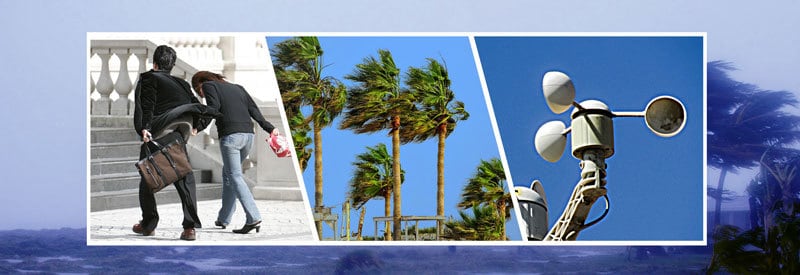
One type of meteorological event almost every reader will be familiar with is wind. In this article, we examine what exactly wind is, how it forms, the different wind types, and its impact on weather systems.
Wind is the large-scale movement of air from a high to a low-pressure area in the atmosphere. The wind strength is determined by the physical distance between a high and low-pressure region as well as the difference in air pressure strength between them, which is known as the pressure gradient.
Although every one of us is familiar with wind, few know how it develops and its importance. It plays an essential role in the creation of weather. It also has several other benefits, some of which will be discussed in this article.
So, as inconvenient and unpleasant it can be to the majority of us at times, it is a very necessary inconvenience. This article will focus on how wind is formed, the different types of winds, as well as how it is measured.
How Are Winds Formed
Like many other weather events, the creation of winds starts with the heating of the Earth's surface by the sun. Not every surface warms up in the same manner, resulting in some regions being much warmer or cooler than another area with a different surface.
An area with a warm surface warms up the air above it, causing it to rise. It leaves the remaining air near the ground with a much lower density. This creates what is called a low-pressure system.
An area that does not warm up quickly and stays cool is not heating up the air above it, allowing its density to remain fairly high. This results in a high-pressure system.
Air always flows from an area of high to an area of low pressure. (Simply think of releasing the air out of a balloon that is under pressure. The air blows out to equalize the air pressure.)
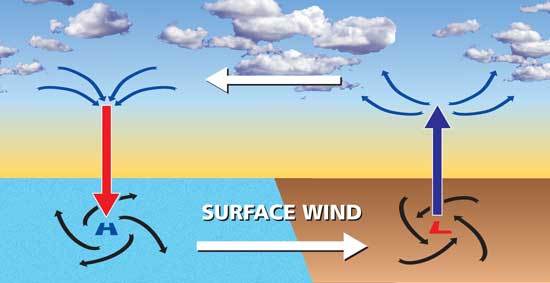
A typical surface wind developed between a high and low-pressure system
This means if a low-pressure and high-pressure area is situated next to each other, the air will always flow from the area of high to the area of low pressure. We experience this movement of air as wind.
As already mentioned, the strength of the wind is largely determined by the distance between the two air pressure systems, as well as the difference in air pressure strength.
The closer the pressure systems are together, the stronger the wind will be, and the further apart, the weaker the wind will be.
Similarly, a big difference in air pressure between the neighboring regions results in a strong wind, while a small difference in pressure creates a much weaker wind.
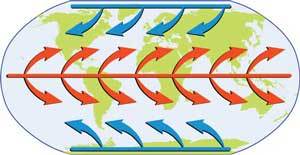
The Coriolis Effect
The rotation of the planet is another major cause of air movement. The process through which this rotation influences global winds is called The Coriolis Effect. You can read all about the Coriolis Effect and how it influences the weather in this article.
The Coriolis Effect and the Global Circulation of air between the warm Equator and cold Polar Regions form the two major driving forces of global wind patterns.
(The latter is a result of the air warming up over the Equator, causing it to rise high into the atmosphere and move towards the Poles. The cold, dense air at the Poles simultaneously moves towards the low-pressure system over the Equator along the surface of the planet.)
The Different Types Of Winds
By now, it should become clear that there is a multitude of forces at work, both on a global and local scale, to create the different forms and patterns of wind.
This brings us to the different types of winds throughout the world. Depending on which article you read, there are three, four, six, or even more types of winds. These discrepancies are a result of the different criteria used to define winds.
Some researchers use the 6 different climate zones to define winds, others use the three major global wind patterns, while some use a combination of these criteria to categorize the different wind types.
It can get be very confusing and frustrating to any reader. The best way to find a balance is to not disregard the major global wind patterns, but at the same time include seasonal (periodic) and local winds. This leaves us with the following six categories.
- The Polar Easterlies (Polar Hadley Cells)
- The Westerlies
- Trade Winds (Tropical Easterlies)
- The Doldrums
- Periodic Winds
- Local Winds
Now that the different types of winds have been broadly identified, each type of wind can be examined in more detail:
1) The Polar Easterlies (Polar Hadley Cells)
The Polar Easterlies are one of the three major global wind patterns. It is found between 60 and 90 degrees latitude in the Polar Regions.
As the name suggests, they blow from east to west and are generally fairly weak and irregular. They are also cold and dry in nature and originate from the high-pressure regions found around the North and South Pole.
2) The Westerlies
Forming the second of the three global wind patterns, The Westerlies can be found between 30 and 60 degrees latitude in the Middle Latitudes.
Again, as the name suggests, they blow from west to east and play an important role in carrying the Equator's warm waters to the western continents.
Unlike The Polar Easterlies, The Westerlies are strong winds that also play a vital role in pushing warm water from the Subtropical Regions towards The Poles.
3) Trade Winds (Tropical Easterlies)
Rounding off the three global wind patterns, Trade Winds can be found between 0 and 30 degrees latitude in the Tropical Regions.
These are the prevailing easterly winds that blow from west to east in the Tropics north and south of the Equator. Trade winds received their name as a result of their use by the early sailors to navigate the vast Atlantic to establish trade routes between the East and the West.
Trade Winds in the warm waters of the Tropics are also responsible for the creation of tropical storms, including cyclones, hurricanes, and typhoons. You can read all about how these storms are formed in this article.
4) The Doldrums
The doldrums is a narrow band of air across the Equator that can be found between the northern and southern Trade Winds.
It is also the region where warm air rises from the heated surface into the atmosphere, where it starts to move to the North and South Poles, respectively.
The winds are very weak in this low-pressure area, and the region is sometimes characterized by periods of no wind activity.
5) Periodic Winds
Also called seasonal winds, these winds are usually associated with a specific season of the year when prevailing winds develop to create a particular weather pattern.
The most prominent example, the Monsoon Winds, blow from the southwest to bring hot and humid air to India and Southeast Asia during the summer. These rains provide the much-needed rainfall essential for agriculture in the region.
You can find more information about Monsoon winds at the end of this article.
6) Local Winds
These are all the "normal" winds we experience on a daily basis, which develop as a result of topography, high and low-pressure systems between land and sea, vegetation, etc.
They include land and sea breezes, Föehn winds, valley breezes, as well as anabatic and katabatic winds.
How Wind Speed And Direction Are Measured
The two most important characteristics of wind are its direction and speed. They are equally important, and each one is measured by different devices.
Wind Speed
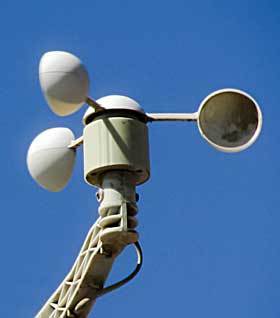
Wind speed is measured by an anemometer. The most widely used anemometer is called a cup anemometer. It is made up of 3-4 hemispherical cups mounted on the edges of horizontal arms. The arms are connected to a central shaft.
As the wind blows, it rotates the cups attached to the horizontal arms, which in turn spins the shaft. Each rotation is counted, and in this way, the wind speed is calculated. The minimum height to get the most accurate reading is considered to be around ten meters.
Anemometers are found on home & professional weather stations, skyscrapers, at airports, even on ships. (Anywhere where winds are of significant importance.) Other types of wind speed devices include vane anemometers and pilot tubes, but not nearly as widely used.
Wind Direction
For the most part, wind direction is measured with a weather (wind) vane. It is a fairly simple device consisting of a vertical flat object that is mounted on a shaft where it is allowed to spin freely. It can literally take any shape but is usually in the form of an arrow or cockerel.
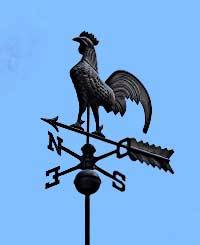
As the wind blows against the object's surface, it rotates with the biggest part pointing in the direction the wind is blowing in. An arrow or cockerel-shaped vane is designed in such a way that the head is always pointing towards the direction the wind is coming from.
Weather vanes are also found on home and professional weather stations, tall buildings and even serve as an ornament on cathedrals and other prominent buildings.
At airports, a weather sock with bright colors is often used to make the wind direction highly visible for pilots and control tower operators. In general, though, a weather vane is preferred for meteorological purposes.
How Does Wind Affect The Weather?
The simple answer to this question is: In almost every possible way. From the smallest sea breeze, Föehn (berg) wind, and fresh breeze funneling through the valley - to Monsoon winds able to supply rain to a whole subcontinent for a whole season, and hurricanes able to destroy coastlines and cause thousands of deaths - all are driven by some form of wind.
Due to strong winds, rain can also fall in areas where no clouds seem to be present. It is a phenomenon called a sunshower or serein.
Simply put, it is almost impossible to think of any weather condition or event that is not influenced by winds in some way.
To mention all the weather conditions that are influenced by wind will almost be able to fill an encyclopedia. The best way to illustrate some of the influences of the wind on specific weather events is to point you to some helpful examples:
If you want to find out more about Föehn winds, you can read the full article here.
If you are interested, you can also read more about land and sea breezes in this article.
To find out more about the role winds play in the formation of hurricanes and monsoons, you can read it in this article.
To find out the crucial role winds play in the formation of weather phenomena like El Niño and La Niña, you can read more in this article.
Conclusion
This article highlighted exactly what wind is, how it is formed, the different types of winds that exist throughout the world, and its impact on the weather.
If you take one thing away from this article, it's that the wind is essential for all life on earth. It brings the rain the land needs to produce crops and fill dams, blows away dangerous weather, clean smog-filled air, and even cool humans/animals down during the heat.
So, next time you get irritated by a gusty wind making your day in the outdoors unpleasant, think of the bigger picture, and you may just feel better about this small inconvenience.
Never miss out again when another interesting and helpful article is released and stay updated, while also receiving helpful tips & information by simply clicking on this link .
Until next time, keep your eye on the weather!

